Overview
Have you ever wondered how manufacturers can truly elevate the eCommerce customer experience? Well, here are five essential steps that can make a real difference:
- Enhancing website usability
- Ensuring product availability
- Improving communication and content quality
- Streamlining the checkout process
- Fostering post-purchase engagement
These strategies aren't just buzzwords; they’re backed by data showing that a strong customer experience can lead to significant revenue growth, lower cart abandonment rates, and increased customer loyalty. It’s fascinating to see how effectively tackling customer experience initiatives can directly correlate with business success, don’t you think?
So, let’s dive deeper into these steps and explore how they can transform your eCommerce game!
Introduction
In the bustling world of digital commerce, customer experience (CX) has become a game changer for manufacturers aiming to stand out. Think about it: a great CX not only differentiates a brand but also boosts sales and builds loyalty. In fact, studies show that companies focusing on customer satisfaction can see revenue increases of up to 700 million dollars in just three years!
But here's the catch—one in three customers will ditch a brand after just one bad experience. This really raises the stakes for manufacturers to enhance their online shopping environments.
So, what can manufacturers do to elevate their eCommerce customer experience and set themselves up for long-term success?
Understand the Importance of eCommerce Customer Experience
In today's digital marketplace, client interaction (CX) is essential for manufacturers. A strong e commerce customer experience not only distinguishes your brand from competitors but also significantly influences sales retention and client loyalty. Did you know that firms focusing on client satisfaction can anticipate a revenue boost of up to 700 million dollars within three years of investing in CX initiatives? Moreover, businesses with outstanding client satisfaction see revenue grow 5.1 times faster than those with subpar interactions. This really highlights the . And here's a striking fact: 80% of clients say that a smooth digital interaction is just as important as the product itself, underscoring the importance of a robust CX. It's crucial to recognize that 1 in 3 clients will abandon a brand they love after just one negative experience. This really emphasizes the need to uphold high CX standards.
Now, let’s dive into some key elements of eCommerce customer experience that can make a difference:
- User-Friendly Interface: A well-structured website allows customers to navigate effortlessly, making it easy for them to discover products quickly.
- Personalization: Tailoring the shopping experience to individual preferences and past behaviors fosters deeper connections and encourages repeat purchases. Studies show that personalized interactions can lead to a 20-30% increase in conversion rates.
- Responsive Design: With 60% of consumers preferring mobile apps for convenience, optimizing your site for mobile devices is essential to capture this audience.
- Client Support: Accessible support options throughout the shopping experience enhance client satisfaction and retention. Businesses that view service to clients as a value center experience 3.5 times more revenue growth than those that see it as a cost center.
By focusing on these aspects, manufacturers can create an engaging e commerce customer experience that not only meets client expectations but also drives significant sales growth and fosters lasting loyalty. So, what steps will you take to enhance your CX today?
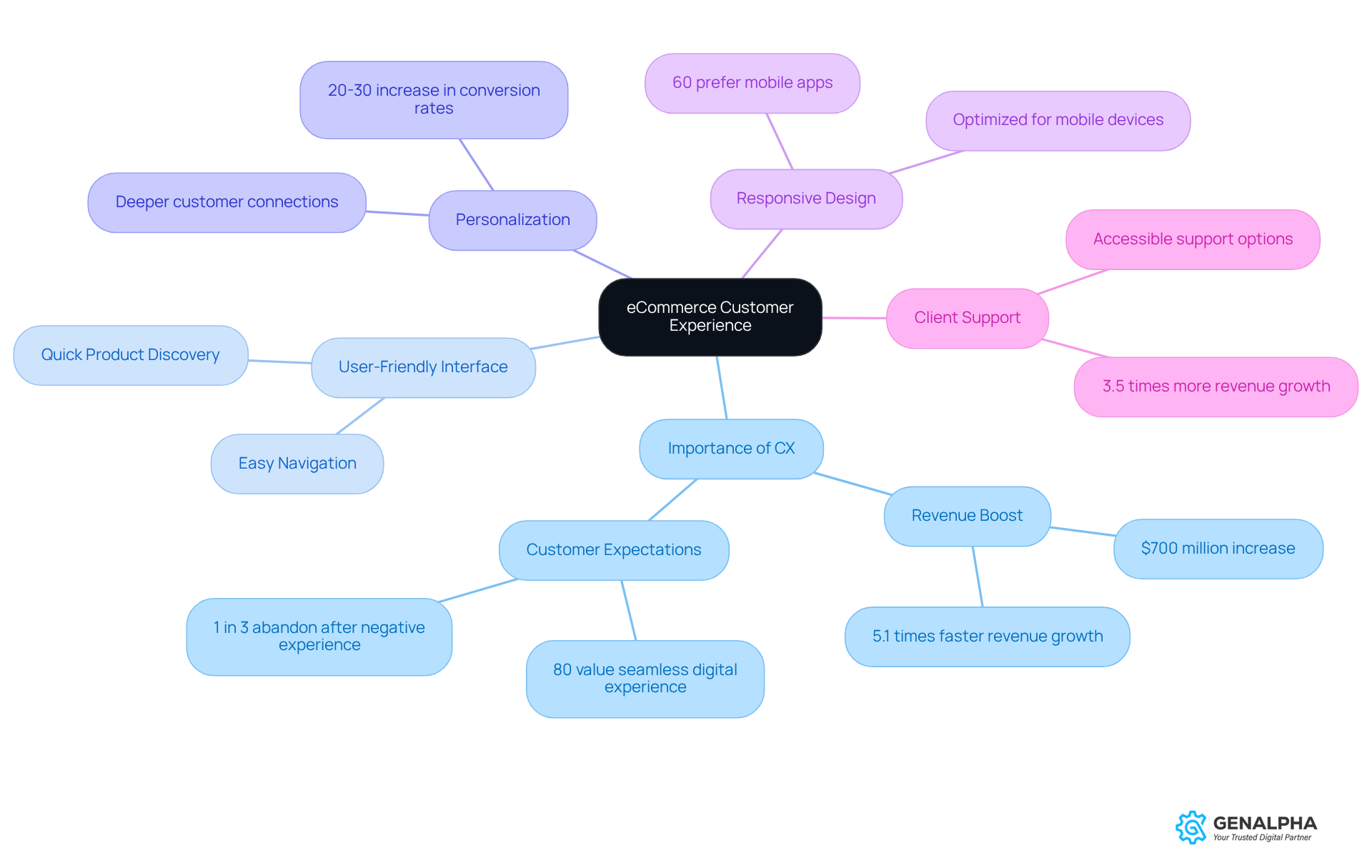
Ensure Availability and Accessibility for Customers
To improve client experience, manufacturers should really focus on making their offerings available and accessible. This means putting robust inventory management systems in place that provide real-time stock updates. So, how can we achieve this? Here are some essential steps:
- Implement Real-Time Inventory Tracking: Let’s leverage technology to keep an eye on stock levels and update your website in real-time. This proactive approach helps prevent clients from running into out-of-stock items, which enhances satisfaction and reduces those lost sales opportunities. Did you know that persistent stockouts cost retailers nearly $1 trillion annually? This really shows how crucial effective inventory management is.
- Optimize Item Listings: Make sure your item descriptions are detailed and clear, giving buyers all the information they need. This transparency helps them make informed purchasing decisions, building trust and boosting conversions. As Steve Jobs famously said, "Innovation differentiates a leader from a follower," which emphasizes the importance of adjusting product listings to meet buyer expectations.
- Enhance Website Accessibility: It’s essential to follow accessibility standards so that everyone, including those with disabilities, can easily navigate and purchase from your website. This inclusivity not only broadens your customer base but also improves overall user satisfaction.
- Utilize : Expand your reach by selling on various platforms like Amazon and eBay. This strategy not only increases product visibility but also ensures that shoppers can easily find your items, no matter where they prefer to shop. Companies like Purple Dot have shown how effective pre-order systems can be for helping retailers recover missed sales and optimize inventory management.
By focusing on these strategies, manufacturers can significantly enhance the e commerce customer experience, boost sales, and achieve greater business success. So, are you ready to take these steps and elevate your client experience?
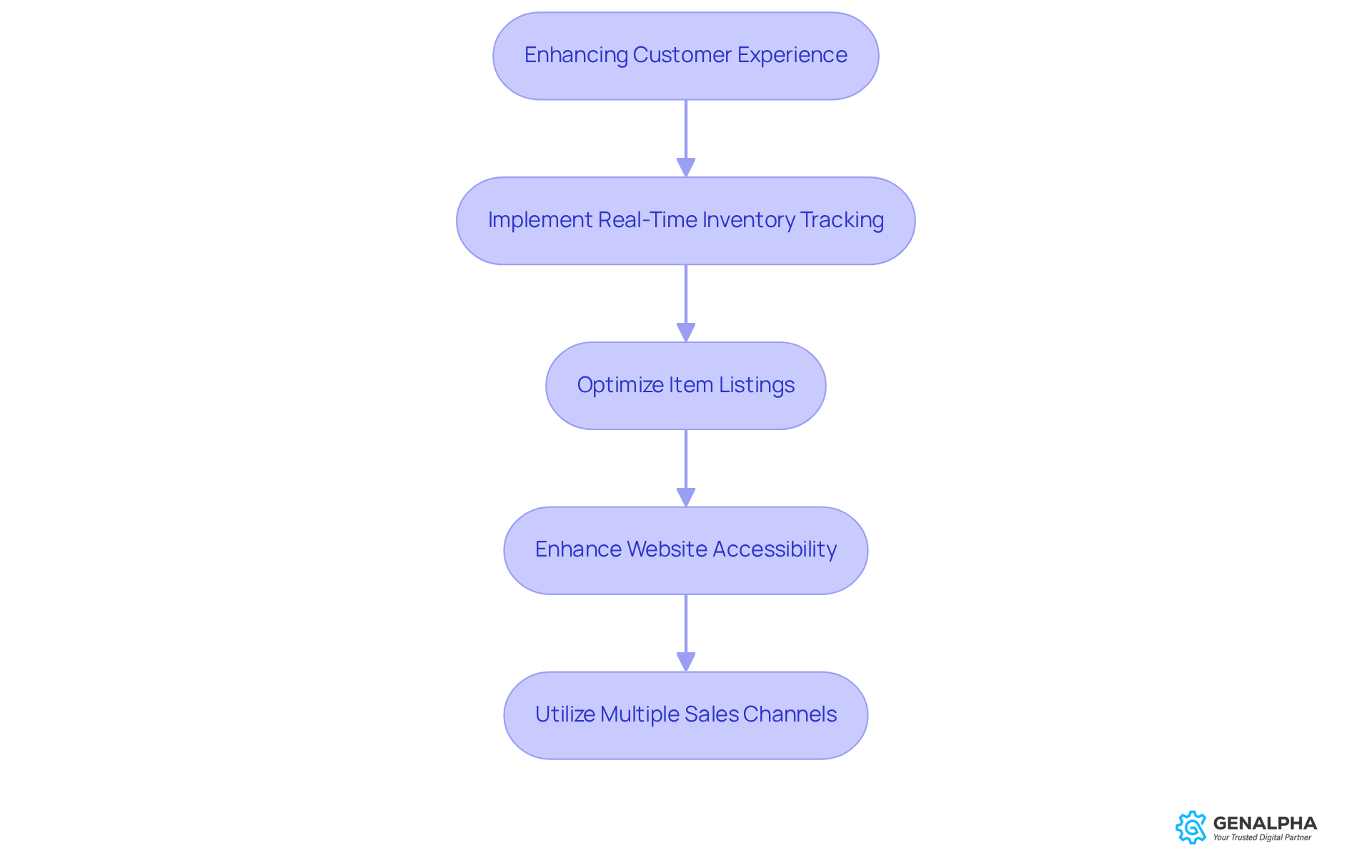
Enhance Communication and Content Quality
Effective communication and high-quality content are crucial for enhancing the experience of clients in manufacturing. So, how can manufacturers make a real impact? Here are some key strategies to consider:
- Craft Clear Product Descriptions: Use straightforward language to share all the important details, like specifications, benefits, and usage instructions. Providing detailed information not only educates clients but also enhances the e-commerce customer experience by boosting conversion rates and lowering return rates through clear expectations. As Abigail Rice points out, "By offering detailed item information, not only can manufacturers enhance conversions, but decrease returns, as knowledgeable buyers are less likely to feel let down."
- Leverage Visual Content: Think about integrating high-quality images and videos to showcase your products effectively. Visual content plays a significant role in buying decisions, helping individuals envision the item and understand its features. Engaging stories through video can also cater to client needs at various stages of their purchasing journey, from awareness to decision-making. Plus, video content is key, as it can significantly boost lead conversion rates and enhance brand credibility.
- Offer Live Chat Support: Have you considered adding live chat options on your website? This feature provides real-time assistance and caters to 51% of shoppers who prefer e-commerce businesses with , allowing for immediate answers to questions and guidance throughout the purchasing process.
- Create Informative Resources: Why not develop blog posts, guides, and FAQs that tackle common inquiries and provide valuable insights about your products? This approach not only enhances client knowledge but also positions your brand as a reliable resource, fostering loyalty and encouraging repeat business. Moreover, self-service tools empower users to find solutions on their own, boosting their satisfaction and reducing the number of basic queries for support teams.
By focusing on transparent communication and top-notch content, manufacturers can enhance the e-commerce customer experience, build trust with clients, and create a smoother purchasing process, ultimately increasing sales and improving client satisfaction. What strategies will you implement to enhance your communication?
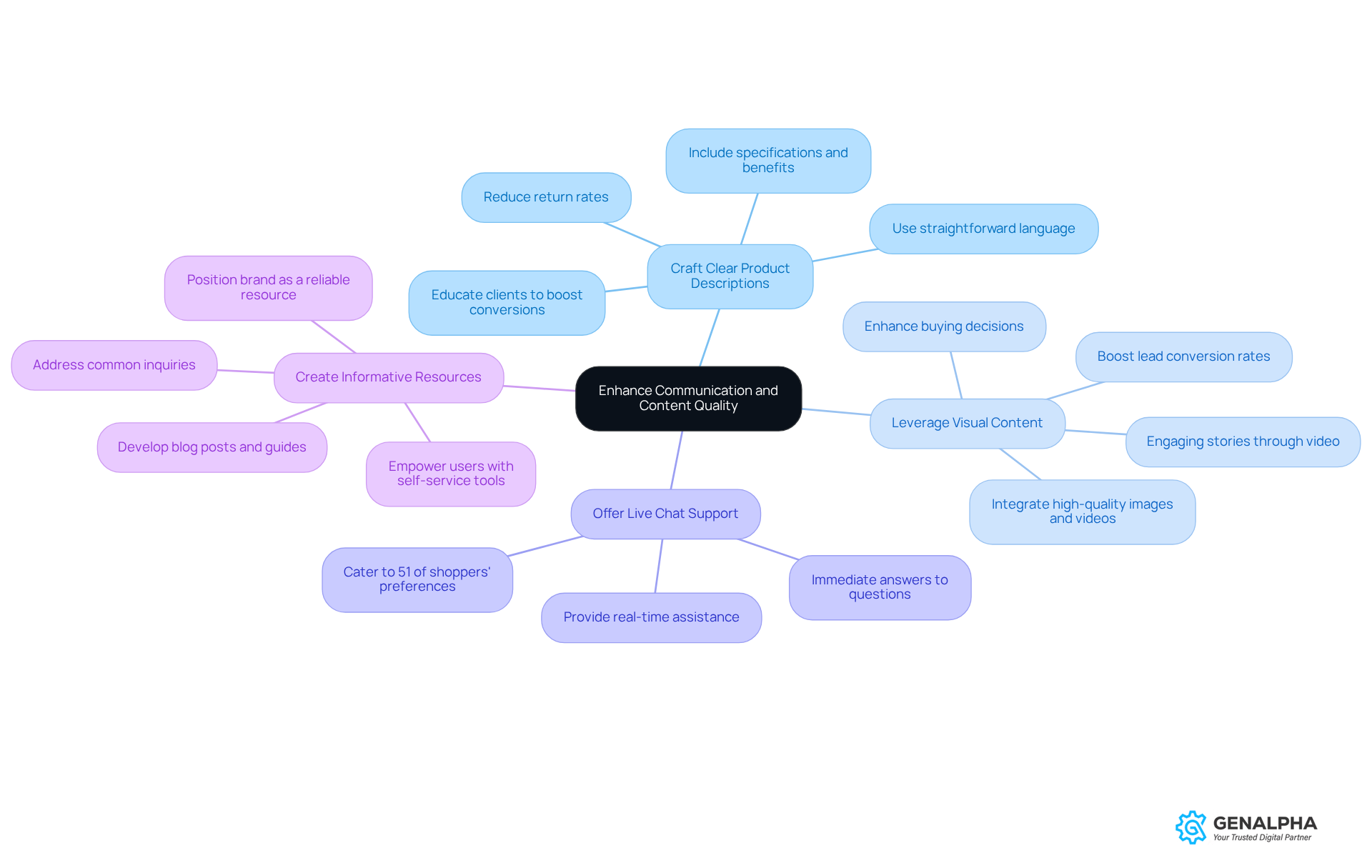
Streamline the Checkout Process
The checkout process is such a vital part of the buyer journey, and improving it can significantly enhance the e commerce customer experience, leading to a big drop in cart abandonment rates. So, how can we enhance your checkout experience? Here are some key strategies:
- Simplify the Checkout Flow: Streamlining the purchasing process by cutting down on the number of steps can really boost user satisfaction. Have you considered a one-page checkout? It’s been shown to work wonders by reducing friction and speeding up transactions. Research reveals that 62% of consumers abandon their carts if they hit a snag during checkout, highlighting the importance of a reliable payment system.
- Offer Multiple Payment Options: Think about providing a variety of payment methods—credit cards, digital wallets, and even alternative financing options. This caters to different client preferences. Did you know that 70% of buyers might look elsewhere if their preferred payment method isn’t available? That’s why accommodating various payment options is crucial. Companies that embrace this strategy often see nearly a 30% boost in revenue. Impressive, right?
- Display Trust Signals: Adding security badges and customer testimonials on your checkout page can really reassure buyers about the safety of their transactions. Trust can be a game changer; in fact, 62% of consumers are likely to stick with brands that provide smooth, .
- Allow Guest Checkout: Letting folks make purchases without creating an account can significantly ease the buying process. This not only enhances convenience but also encourages more buyers to complete their purchases. Take the BeadSmith case study, for example. They focused on optimizing their payment systems, leading to a notable reduction in checkout abandonment and a boost in overall sales.
By implementing these strategies, you can create a more efficient e commerce customer experience during checkout that not only reduces cart abandonment but also fosters client loyalty and satisfaction. Ready to give it a try?
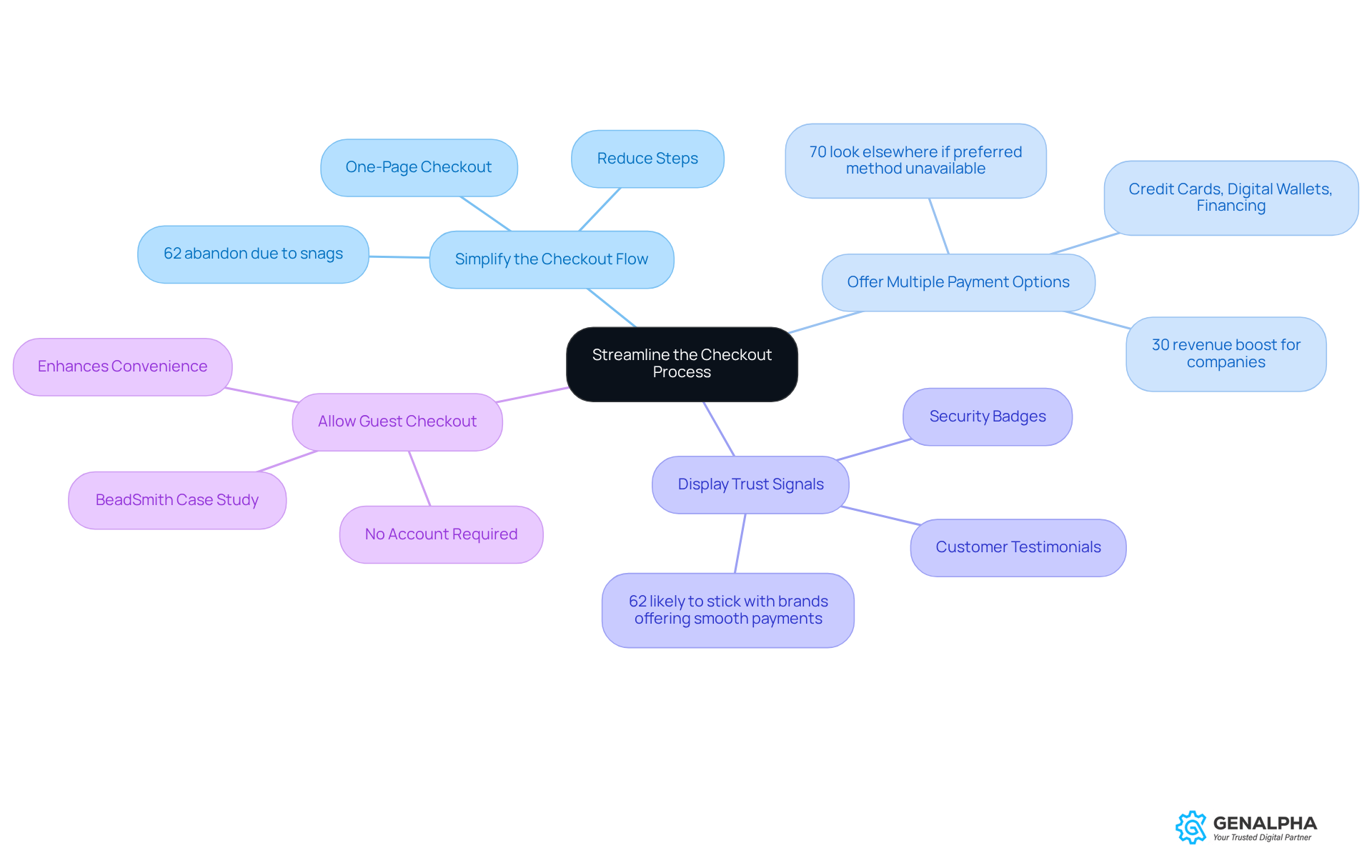
Foster Post-Purchase Engagement and Support
Post-purchase involvement is super important for keeping customers happy and encouraging them to come back. Here are some effective strategies to boost this engagement:
- Send Thank You Emails: After a purchase, why not send a personalized thank you email? It’s a great way to express gratitude and reinforce the buyer's decision. Research shows that quick thank you emails can significantly enhance the e commerce customer experience, leading to better satisfaction ratings and an improved purchasing experience. Think about it: a loyal client can be worth up to 10 times their initial order. That really highlights how crucial this engagement is!
- Request Feedback: Actively inviting clients to share their thoughts on their purchase experience is key. This not only shows that you value their opinions but also gives you valuable insights into areas that might need a little improvement. Businesses that make client feedback a priority often see a noticeable increase in loyalty and retention rates, which significantly improves the e commerce customer experience. As Shivani Dubey puts it, "Listening to and acting on feedback doesn’t just enhance what the business provides, but it also shows clients that you genuinely care."
- Offer Loyalty Programs: Think about creating loyalty programs that reward returning customers with discounts or exclusive offers. These initiatives encourage patrons to come back, fostering a sense of belonging and appreciation. In fact, effective loyalty programs in manufacturing eCommerce have shown a significant boost in lifetime value.
- Offer Continuous Assistance: Make sure clients have access to solid support after their purchase, whether it’s through detailed FAQs, live chat options, or dedicated service hotlines. This ongoing support not only helps resolve issues but also builds trust and satisfaction among clients. Tools like Flux Checkout can make easier, allowing you to gather insights from users effortlessly.
By focusing on post-purchase engagement, manufacturers can improve the e commerce customer experience, build lasting relationships with clients, and lead to enhanced loyalty and increased repeat sales. For example, Looka's adjustments based on customer feedback show the real benefits of listening to customers and adapting strategies accordingly.
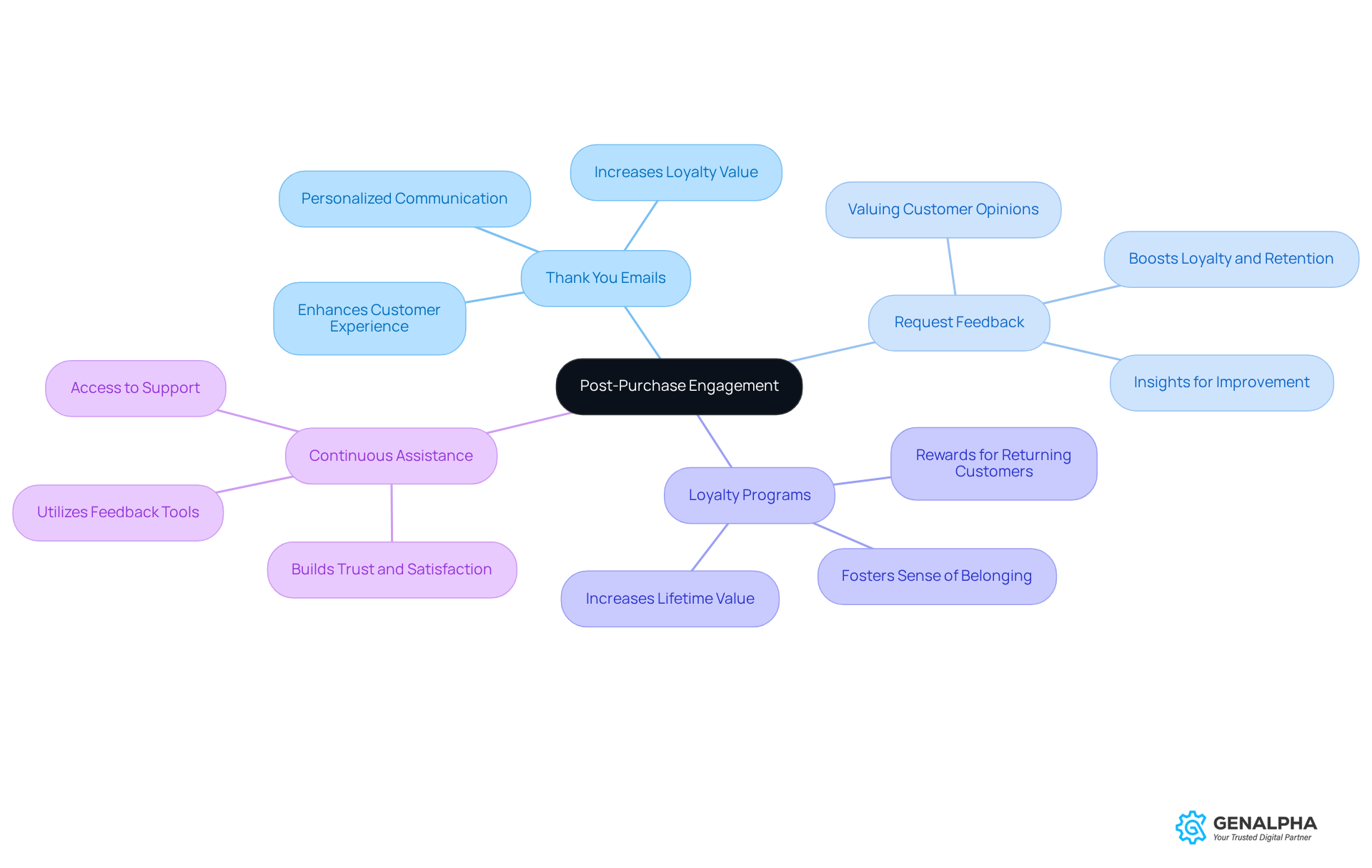
Conclusion
A compelling eCommerce customer experience is essential for manufacturers looking to thrive in today’s competitive digital landscape. By putting client satisfaction first, businesses can not only stand out but also drive significant growth and build lasting loyalty. The link between exceptional customer experiences and increased revenue is clear, as the statistics show just how much CX impacts sales retention and client loyalty.
In this article, we’ve outlined key strategies to enhance the eCommerce customer experience:
- Creating a user-friendly interface
- Ensuring accessibility
- Optimizing the checkout process
- Fostering post-purchase engagement
Every element is crucial in shaping customer perceptions and driving conversions. Plus, emphasizing clear communication and high-quality content strengthens the relationship between manufacturers and their customers, leading to greater trust and satisfaction.
Ultimately, investing in eCommerce customer experience is vital. Manufacturers are encouraged to take actionable steps toward enhancing their CX strategies, ensuring they not only meet but exceed customer expectations. By doing this, they’ll improve client satisfaction and position themselves for sustained success in the ever-evolving eCommerce landscape. So, what steps will you take today to elevate the customer experience and secure a competitive advantage?
Frequently Asked Questions
Why is eCommerce customer experience (CX) important for businesses?
eCommerce customer experience is crucial because it differentiates brands from competitors, influences sales retention, and enhances client loyalty. Companies focusing on CX can expect significant revenue boosts and faster growth compared to those with poor customer interactions.
What financial benefits can businesses expect from investing in customer satisfaction?
Firms that invest in customer satisfaction can anticipate a revenue increase of up to 700 million dollars within three years. Additionally, businesses with outstanding client satisfaction experience revenue growth 5.1 times faster than those with subpar interactions.
What percentage of customers value a smooth digital interaction as much as the product itself?
80% of customers believe that a smooth digital interaction is just as important as the product itself.
How does a negative experience affect customer loyalty?
One in three customers will abandon a brand they love after just one negative experience, highlighting the importance of maintaining high CX standards.
What are key elements that enhance eCommerce customer experience?
Key elements include a user-friendly interface, personalization, responsive design, and accessible client support.
How does personalization impact conversion rates?
Personalization can lead to a 20-30% increase in conversion rates by tailoring the shopping experience to individual preferences and past behaviors.
Why is responsive design important for eCommerce websites?
Responsive design is essential because 60% of consumers prefer using mobile apps for convenience, and optimizing sites for mobile devices helps capture this audience.
What role does client support play in customer satisfaction?
Accessible client support options throughout the shopping experience enhance satisfaction and retention. Businesses that view client service as a value center experience 3.5 times more revenue growth than those that see it as a cost center.
What steps can manufacturers take to improve availability and accessibility for customers?
Manufacturers can implement real-time inventory tracking, optimize item listings, enhance website accessibility, and utilize multiple sales channels to improve availability and accessibility.
How can real-time inventory tracking benefit customer experience?
Real-time inventory tracking helps prevent customers from encountering out-of-stock items, enhancing satisfaction and reducing lost sales opportunities.
Why is it important to optimize item listings?
Optimizing item listings with detailed and clear descriptions helps buyers make informed purchasing decisions, builds trust, and boosts conversions.
How can enhancing website accessibility improve customer experience?
Following accessibility standards ensures that everyone, including individuals with disabilities, can easily navigate and purchase from the website, broadening the customer base and improving overall satisfaction.
What is the benefit of utilizing multiple sales channels?
Selling on various platforms like Amazon and eBay increases product visibility and ensures that shoppers can easily find items, enhancing the overall shopping experience.




